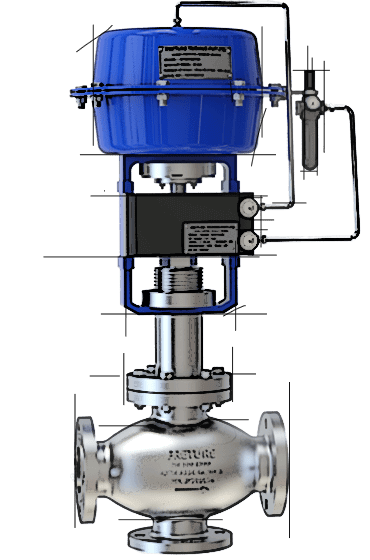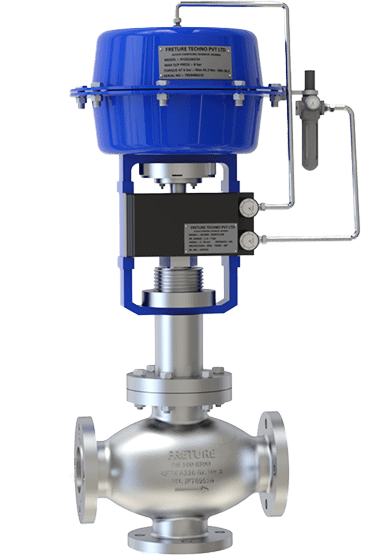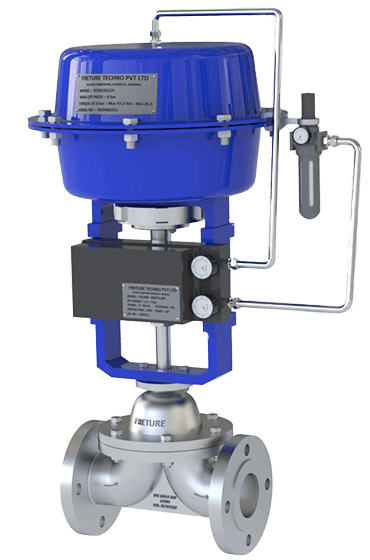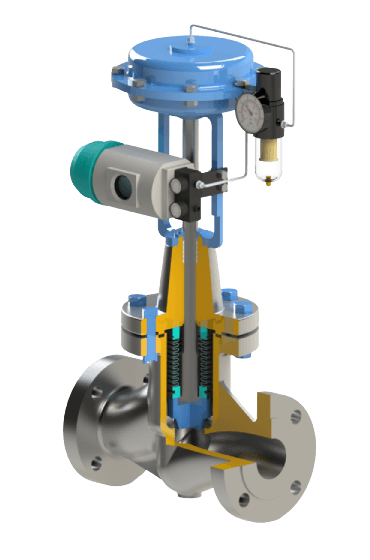It is a device used to regulate the flow of a fluid (liquid or gas) by varying the size of the flow passage. It can maintain process variables such as flow, pressure, temperature, and liquid level within a desired operating range.
Control Valve
FRETURE is a leading Automatic flow control valve manufacturer based in Mumbai, India, adhering to international manufacturing standards such as ISO and ANSI. Our expertise lies in producing high-quality control valves that ensure precise regulation of fluid and gas flow across various industries.
These valves are integral components in fluid control systems, serving to modulate the flow rate, pressure, and temperature of liquids or gases within pipelines. These valves operate by either restricting or allowing the passage of fluid through the valve body, thereby controlling the flow as per the desired parameters.
Types and Operation
There are several types of control valves designed to suit specific applications and operational requirements. Globe valves offer excellent throttling capabilities and are commonly used for precise flow control. Angular type valves are ideal for high- pressure applications due to their robust design. "Y" valves, on the other hand, are suitable for applications requiring high flow capacity and low pressure drop. Bellow seal valves provide enhanced sealing integrity, making them suitable for applications involving hazardous or corrosive fluids. 2-way globe control valve and 3-way globe control valves offer versatility, allowing for either diverting or mixing flow. Diaphragm valves are particularly effective in applications requiring cleanliness and sterility.
Additionally, control valves can operate using different methods, such as pneumatic control, where air pressure is used to actuate the valve, and electronic pressure control, where electronic signals control the valve's position and flow rate.
Applications
These valves find application across various industries, including oil and gas, chemical processing, power generation, water treatment, and HVAC systems. In oil and gas production, they are used to regulate the flow of crude oil, natural gas, and other fluids in pipelines and processing facilities. In chemical processing plants, they control the flow of various chemicals and solvents. Power generation plants utilise these valves to regulate steam flow in boilers and turbines. Water treatment facilities rely on these valves for precise control of water flow and chemical dosing. Additionally, These valves are used in heating, ventilation, and air conditioning (HVAC) systems for temperature and pressure control.
Manufacturing Excellence
Our manufacturing process begins with meticulous design and engineering, ensuring that each valve meets specific industry requirements. We adhere strictly to international standards such as ASTM (American Society for Testing and Materials), ASME (American Society of Mechanical Engineers), ISA (International Society of Automation), and ANSI (American National Standards Institute) throughout the manufacturing journey.
Testing to Perfection
Quality is at the core of everything we do at Freture. These valves undergo rigorous testing procedures, including hydrostatic and pneumatic pressure testing, in accordance with ASTM and ASME standards. Additionally, flow testing per ISA standards evaluates valve response to varying flow conditions, guaranteeing accurate modulation and control. Leakage testing, following ANSI guidelines, ensures tight shut-off performance, giving you peace of mind regarding valve reliability.
Compliance with International Standards
Freture's commitment to quality extends to compliance with international standards. ASTM standards govern material selection, ensuring durability and performance. ASME standards guide manufacturing processes, ensuring consistency and safety. ISA standards validate instrumentation and control systems, while ANSI standards set benchmarks for pressure testing and performance criteria.

FAQ’s
Have a question before you buy our products? Take a look at the FAQs below.
If you don’t find the answer you’re looking for, get in touch with us here.
- What is a Control Valve?
- How does a it work?
It operates by adjusting the position of an internal element (such as a plug, ball, or butterfly) to control the flow rate. The valve's position is typically adjusted by an actuator, which is controlled by an external controller
- What are the main types?
The main types include:
- Globe 2 Way : controlling flow in two directions.
- Globe 3 Way : managing flow in three directions.
- Diaphragm : using a flexible diaphragm for flow regulation.
- Flush Bottom : with a flush bottom for easy cleaning and draining.
- What is an actuator in a Control Valve?
An actuator is a mechanism that moves the these valve’s internal element (like a plug or disk) to change the flow rate. Actuators can be pneumatic, electric, or hydraulic
- What factors should be considered when selecting these Valve?
Factors to consider include:
- Type of fluid: Corrosive, viscous, clean, etc.
- Flow rate requirements: Minimum and maximum flow rates.
- Pressure drop: Acceptable pressure loss across the valve.
- Temperature: Operating temperature of the fluid.
- Valve material: Compatibility with the fluid and operating conditions.
- Actuation method: Pneumatic, electric, or hydraulic.
- What are positioner?
It is a device that adjusts the actuator’s position based on the control signal. It ensures the valve reaches the correct position and improves the accuracy and speed of response.
- How do you maintain a it?
Maintenance steps include:
- Regular inspection: Checking for leaks, corrosion, and wear.
- Calibration: Ensuring the actuator and positioner are correctly calibrated.
- Cleaning: Removing any buildup of deposits or debris.
- Lubrication: Ensuring moving parts are properly lubricated.
- Replacement of parts: Replacing worn or damaged parts as necessary.
- What is valve cavitation and how can it be prevented?
Valve cavitation occurs when the pressure of the liquid drops below its vapor pressure, forming vapor bubbles that collapse and cause damage. It can be prevented by:
- Proper valve selection: Using valves designed to handle cavitation.
- Controlling pressure drop: Ensuring the pressure drop is within acceptable limits.
- Using anti-cavitation trims: Specially designed internal valve components that reduce cavitation.
- What is a Control Valve flow coefficient (Cv)?
The flow coefficient (Cv) is a measure of the valve’s capacity to allow flow. It is defined as the flow rate (in gallons per minute) of water at 60°F that will pass through the valve with a 1 psi pressure drop. It helps in selecting the appropriate valve size for a given application.
- How do control valves affect process control?
Control valves are critical in process control as they directly regulate flow rates, pressures, and temperatures, ensuring the process operates within desired parameters. Accurate control valves help maintain product quality, reduce waste, and increase efficiency.
Feel free to ask if you have any more specific questions about control valves!
Industries where these is used
Oil and Gas Industry
Chemical Processing
Power Generation
Natural Gas Industry
Petrochemical Industry
Applications of Control Valve
- Flow Regulation: They adjust fluid flow to ensure desired rates in processes.
- Pressure Control: They maintain stable pressure levels within systems.
- Temperature Control: They regulate temperature by managing heat transfer fluid flow.
- Level Control: They maintain optimal fluid levels in tanks and vessels.
- Mixing and Blending: They ensure accurate fluid mixing and blending.
- Safety and Shutdown Systems: They act as emergency shutdown valves to prevent accidents.
- Environmental Control: They manage airflow and temperature in HVAC systems.





